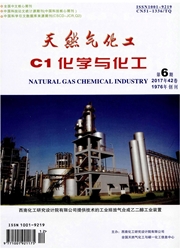

 中文摘要:
中文摘要:
以纤维素为原料使用一种简单的方法制备了渗氮炭材料。通过研究脱硫前后以及不同再生次数的炭材料表面含氮基团的变化,研究含氮基团在炭材料脱硫过程中的作用。采用N2吸附、元素分析、XPS和质谱等表征手段分析制得的炭材料的孔结构、元素组成以及表面含氮基团的分布。结果表明,脱硫前后炭材料表面含氮基团的分布会发生变化,再生会改变炭材料的孔结构、含氮量和表面含氮基团的分布。通过关联不同再生次数的炭材料表面特定种类含氮官能团的含量与SO2吸附量/比表面积,推测吡啶氮在炭材料脱硫过程中起到主要作用。脱硫过程中,可能类吡啶氮会与SO2或SO3结合形成络合物,在热再生过程中分解并释放HCN,导致含氮基团发生变化。
 英文摘要:
英文摘要:
A nitrogen doped carbon material was synthesized in a simple way by using cellulose as the raw material. In order to know the effect of nitrogen-containing groups on the desulfurization performance of the carbon material, the changes of nitrogencontaining groups on the surface of the carbon material before and after using for desulfurization and with different regeneration times. BET, elemental analysis, XPX and MS were employed to analyze the porous structure, elemental composition and nitrogencontaining groups distribution of the carbon materials. Results showed that the distribution of nitrogen-containing groups on the surface of the carbon material changed obviously after using for desulfurization, while the regeneration affected the pore structure,surface nitrogen content and nitrogen-containing groups distribution. By correlating the contents of specific nitrogen-containing groups of the carbon materials generated in different times with SO2 adsorption capacity versus surface area of carbon material, a conclusion was drown that the pyridine-like nitrogen(N-6) played a vital role in the process of desulfurization. N-6 could combine with SO2 or SO3 to form complex, and the complex could decompose and release HCN during generation, which resulted in the change of nitrogen-containing groups.
 同期刊论文项目
同期刊论文项目
 同项目期刊论文
同项目期刊论文
 Study of SO2 oxidation over V2O5/activated carbon catalyst using in situ diffuse reflectance infrare
Study of SO2 oxidation over V2O5/activated carbon catalyst using in situ diffuse reflectance infrare Catalytic role of vanadium(V) sulfate on activated carbon for SO2 oxidation and NH3-SCR of NO at low
Catalytic role of vanadium(V) sulfate on activated carbon for SO2 oxidation and NH3-SCR of NO at low 期刊信息
期刊信息
